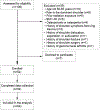Investigating the multifactorial etiology of supraspinatus tendon tears
- PMID: 37814893
- PMCID: PMC10932906
- DOI: 10.1002/jor.25699
Investigating the multifactorial etiology of supraspinatus tendon tears
Abstract
The purpose of this study was to develop a multivariable model to determine the extent to which a combination of etiological factors is associated with supraspinatus tendon tears. Fifty-four asymptomatic individuals (55 ± 4 years) underwent testing of their dominant shoulder. Diagnostic ultrasound was used to assess for a supraspinatus tendon tear. The etiological factors investigated included demographics (age and sex), tendon impingement during shoulder motion (via biplane videoradiography), glenohumeral morphology (via computed tomography imaging), family history of a tear (via self-report), occupational shoulder exposure (via shoulder job exposure matrix), and athletic exposure (via self-report). Univariate relationships between etiological predictors and supraspinatus tears were assessed using logistic regression and odds ratios (ORs), while multivariable relationships were assessed using classification and regression tree analysis. Thirteen participants (24.1%) had evidence of a supraspinatus tear. Individuals with a tear had a higher critical shoulder angle (OR 1.2, p = 0.028) and acromial index (OR 1.2, p = 0.016) than individuals without a tear. The multivariable model suggested that a tear in this cohort can be explained with acceptable accuracy (AUROC = 0.731) by the interaction between acromial index and shoulder occupational exposure: a tear is more likely in individuals with a high acromial index (p < 0.001), and in individuals with a low acromial index and high occupational exposure (p < 0.001). The combination of an individual's glenohumeral morphology (acromial index) and occupational shoulder exposure may be important in the development of supraspinatus tears.
Keywords: etiology; morphology; occupational shoulder exposure; rotator cuff tear; supraspinatus.
© 2023 Orthopaedic Research Society.
Figures




References
-
- Roe Y, Bautz-Holter E, Juel NG, et al. 2013. Identification of relevant International Classification of Functioning, Disability and Health categories in patients with shoulder pain: a cross-sectional study. J Rehabil Med 45:662–669. - PubMed
-
- Moor BK, Wieser K, Slankamenac K, et al. 2014. Relationship of individual scapular anatomy and degenerative rotator cuff tears. J Shoulder Elbow Surg 23:536–541. - PubMed
-
- Tetreault P, Krueger A, Zurakowski D, et al. 2004. Glenoid version and rotator cuff tears. J Orthop Res 22:202–207. - PubMed
Publication types
MeSH terms
Grants and funding
LinkOut - more resources
Full Text Sources
Medical

